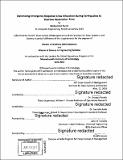Optimizing emergency response crew allocation during earthquakes to improve restoration time
Author(s)
Kurdi, Mohamed (Mohamed Reda)
DownloadFull printable version (5.471Mb)
Other Contributors
Sloan School of Management.
Advisor
Georgia Perakis and Saurabh Amin.
Terms of use
Metadata
Show full item recordAbstract
Northern California and specially the San Francisco Bay Area where PG&E operates is very susceptible to earthquakes. United States Geological Survey (USGS) estimates a 63 percent chance that a magnitude-6.7 or larger earthquake will hit the Bay Area by the year 2036. The chances for a 7.0-magnitude or above are about 50 percent. In this thesis, we first present the methodology PG&E uses to generate predicted damages. Then, we will discuss what data will be available to us and outline how this data is transformed into predicted damages for pipes. Then, the thesis go over the method we used to generate the predicted customer service calls per area. It will first present how PG&E currently estimates the number. Then, it will present a model that can provide better accuracy for estimating the numbers. Next, we present a resource allocation model to optimize repair crew allocation between divisions. We will present how the resource allocation problem can be formulated as a load-balancing problem. We present different formulations and discuss the run time and benefits/drawbacks of each model. We formulate a two-stage optimization model and a one-stage optimization model. We ran both models on different scenarios and we compared the results. We also highlight some key insights we got from combining the travel and allocation problem in a single stage optimization problem. We also go over the sources of uncertainty we have in our data. There are three sources of uncertainty in the model. In this thesis, we will model one of the sources of uncertainties and outline how the other two can be incorporated into the model in the future. Finally, we generated ideal outputs for some of the likely USGIS scenarios that PG&E includes in their emergency response plan. The results from this model would be a critical input to PG&E's emergency response team during an earthquake event. The better we are at predicting damage and allocating resources, the better we will be at minimizing earthquake impact on communities.
Description
Thesis: S.M. in Engineering Systems, Massachusetts Institute of Technology, School of Engineering, Institute for Data, Systems, and Society, 2017. Thesis: M.B.A., Massachusetts Institute of Technology, Sloan School of Management, 2017. "June 2017." Cataloged from PDF version of thesis. Includes bibliographical references (page 48).
Date issued
2017Department
Massachusetts Institute of Technology. Engineering Systems Division; Massachusetts Institute of Technology. Institute for Data, Systems, and Society; Sloan School of ManagementPublisher
Massachusetts Institute of Technology
Keywords
Institute for Data, Systems, and Society., Engineering Systems Division., Sloan School of Management.